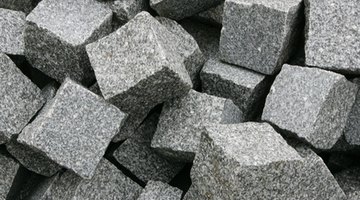Granite Vs. Bluestone
Both blue stone and granite are popular building materials prized for their durability and versatility. Both stones are often seen in large buildings and architectural and landscaping elements.

Uses
Blue stone is used for a wide variety of purposes, including bridges, driveways, walls, steps, landings and indoor projects. However, it is most commonly employed to build outdoor paving areas, like walkways and patios, according to The Stone Yard.
Granite is also versatile, but is especially used in large building projects for structural stones, wall cladding, roofing, flooring and interior and exterior decorating.
Composition
Blue stone is a specific type of fine-grained sandstone called arkosic sandstone that appears blue when it has just been broken or is wetted. However, it exists in a variety of colors and is also known as feldspathic sandstone.
Granite is an igneous rock primarily composed of feldspar, quartz and at least one dark mineral. It was named for its granular texture.
Qualities
While blue stone is durable and crack-resistant, it is most valued for its ability to easily separate into almost any size slab, according to The Stone Yard.
Granite is the hardest of all building stones, homogeneous in texture, durable, resists weathering, has a high load bearing capacity, crushing strength and abrasive strength, cuts and shapes without secondary flaws, takes a mirror polish and is stain resistant.
The Drip Cap
- Both blue stone and granite are popular building materials prized for their durability and versatility.
- It was named for its granular texture.
- While blue stone is durable and crack-resistant, it is most valued for its ability to easily separate into almost any size slab, according to The Stone Yard.
Writer Bio
Elizabeth Jennings began publishing creative works in 1988 and has been a professional editor and writer since 2002. She holds a dual Bachelor of Arts in anthropology and philosophy.
Photo Credits
- granite image by Andrzej Solnica from Fotolia.com
- granite image by Andrzej Solnica from Fotolia.com
More Articles



